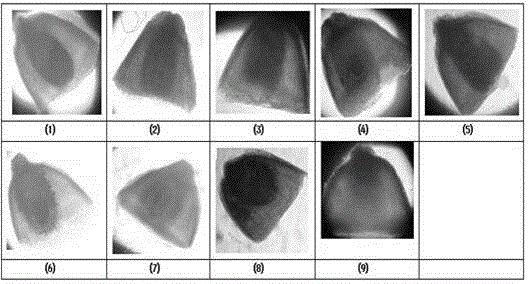Method for rapidly detecting viability of aeluropus littoralis seeds
A viability and seed technology, which is applied in the field of rapid detection of the viability of Roegrass seeds, can solve problems such as long detection time, and achieve the effects of shortening soaking time, reducing mildew, and reducing mechanical damage.
- Summary
- Abstract
- Description
- Claims
- Application Information
AI Technical Summary
Problems solved by technology
Method used
Image
Examples
preparation example Construction
[0025] Solution preparation:
[0026] 1. Preparation method of TTC solution: Prepare two solutions: solution Ⅰ: dissolve 9.078g potassium dihydrogen phosphate (KH2PO4) in 1000ml water; solution Ⅱ: dissolve 9.472g disodium hydrogen phosphate (Na2HPO4) in 1000ml water, or Dissolve 11.876g of disodium hydrogen phosphate (Na2HPO4·2H2O) in water. Take 2 parts of solution I and 3 parts of solution II and mix to obtain a buffer solution. The pH value of the buffer solution is kept in the range of 6.5-7.5. Dissolve tetrazolium powder in the buffer solution in proportion to obtain a definite concentration. Put it into a brown reagent bottle and store it at 4°C for use.
[0027] 2. Preparation method of lactic acid phenol transparent grade: Add 10g phenol into 10mL distilled water, heat to dissolve, then add 10g lactic acid (specific gravity 1.21) and 20g glycerin.
[0028] Calculation method of seed viability of roe chinensis: seed viability of roe chinensis = number of seeds whose...
Embodiment 1
[0031] A method for rapidly detecting the viability of roe chinensis seeds, comprising the following steps:
[0032] (1) First soak 50 roewort seeds (collected in northern Shouguang County, Shandong Province in 2014) in 1.2 mg / L ozone water for 2 minutes, take out and add 8% alkyl glycoside and 12% fatty acid methyl ester ethoxylate Soak the seeds in an aqueous solution, wait for the seeds to swell evenly, and then cross-cut along the 3 / 4 of the seed embryo;
[0033] (2) the TTC solution and the zinc gluconate solution of 0.3% (the zinc gluconate solution used in the present invention is the aqueous solution of zinc gluconate, the following implementation The same as above) according to the mass ratio of 5:1, the mixture was dyed in a dark environment at 30°C, then rinsed twice with distilled water, and then soaked with lactic acid phenol transparent agent at 38°C for 30 minutes. Observe the dyeing condition of the seeds of Roe chinensis, the dyeing is uniform, consistent, br...
Embodiment 2
[0037] A method for rapidly detecting the viability of roe chinensis seeds, comprising the following steps:
[0038] (1) First, soak 50 roewort seeds (collected in Mengcun Hui Autonomous County in the southeast of Hebei Province in 2014) in 1.2mg / L ozone water for 3 minutes, take out and add 5% alkyl glycoside and 15% fatty acid methyl ester B Soak the seeds in an aqueous solution of oxides, wait for the seeds to swell evenly, and then cross-cut along the 3 / 4 of the seed embryo;
[0039] (2) Stain the end of the seed embryo of the roe chinensis seeds with a mixture of TTC solution with a mass percentage of 0.5% and a zinc gluconate solution with a mass percentage of 0.23% according to a mass ratio of 5:1 and place it in a dark environment at 35°C. Then rinse with distilled water for 3 times, and then soak the dyed seeds with lactic acid phenol transparent agent at 38°C for 30 minutes to observe the dyeing of the seeds of roe chinensis. The dyeing is uniform and consistent, and...
PUM
 Login to View More
Login to View More Abstract
Description
Claims
Application Information
 Login to View More
Login to View More - R&D
- Intellectual Property
- Life Sciences
- Materials
- Tech Scout
- Unparalleled Data Quality
- Higher Quality Content
- 60% Fewer Hallucinations
Browse by: Latest US Patents, China's latest patents, Technical Efficacy Thesaurus, Application Domain, Technology Topic, Popular Technical Reports.
© 2025 PatSnap. All rights reserved.Legal|Privacy policy|Modern Slavery Act Transparency Statement|Sitemap|About US| Contact US: help@patsnap.com


